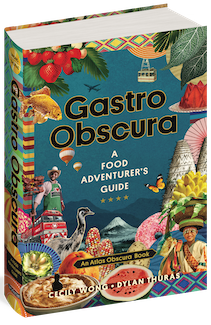Mie Lethek Garuda
In this rare traditional factory, three generations of know-how, several strong cows, and a one-ton mortar come together to make Yogyakarta's famous "ugly noodles."
It’s hard work being a cow. If you happen to be one in the village of Srandakan, in Indonesia’s Yogyakarta Sultanate, you may avoid a more grisly culinary fate by spending your days walking in circles to turn a six-foot-wide, one-ton mortar. This mortar grinds dried cassava and sweet potatoes into flour for use in mie lethek, Yogyakarta’s signature noodle variety. As thanks for all that hard work, you’ll eat a steady diet of sweet grass meant to keep you strong and healthy. But it’s the end result that really matters: You’ll be part of the culinary legacy of Srandakan’s Mie Lethek Garuda, the last remaining traditional mie lethek factory.
Mie lethek means “ugly noodles,” dubbed so because the blend of cassava and sweet potato flours yields squiggly carbs of a pasty, grayish tint. More appealingly, the noodles have a delicate sweet-potato flavor and chewy texture. They’re a regional specialty of Yogyakarta, which is the last remaining Indonesian region to be ruled by a Sultanate. Served either fried or boiled, with eggs, chicken, vegetables, garlic, and candlenuts—an oily nut with a flavor similar to macadamia nuts—they are famously delicious. Barack Obama, the former United States president, is said to have enjoyed mie lethek on a visit to Yogyakarta, though no word on whether those noodles came from the Garuda factory or a more high-tech equivalent.
Yasir Feri, the current owner of Mie Lethek Garuda, credits his grandfather with the invention of these noodles. Feri’s grandfather was a Yemeni immigrant who married a local woman of Chinese descent. It was Feri’s grandmother who had the bright idea to try out cassava flour, and she supplied the noodle-making experience that led to the factory’s success. They opened up shop in the 1940s. Eighty years and two generations later, the younger Feri is the last producer to continue making mie lethek by hand, cow and all. After grinding the cassava and sweet potato flour, factory workers mix it into dough, which they then manually press into noodle form. Then, workers steam the resulting noodles and dry them in the sun for at least a day before sending them to local markets and for distribution throughout Yogyakarta.
Today, the Garuda factory employs around 30 local workers. While Feri could certainly sit back, relax, and savor his status as noodle king, he continues to work alongside his employees, many of whom have been around since his parents’ tenure as factory managers. And of course, Feri always remembers to save some sweet grass for his loyal cows, who have helped give the world a beautiful gift in the form of an ugly noodle.
Know Before You Go
As in many rural areas, the Garuda factory doesn't have a conventional address. But the factory itself is a well-known landmark in Srandakan, a small village in Bantul district. If you're interested in paying the factory a visit, your hotel owners or host in Bantul should be able to show you the way and help arrange transportation. Otherwise, you can try Garuda's noodles in restaurants and markets across Yogyakarta.
Plan Your Trip
The Atlas Obscura Podcast is Back!




















Follow us on Twitter to get the latest on the world's hidden wonders.
Like us on Facebook to get the latest on the world's hidden wonders.
Follow us on Twitter Like us on Facebook